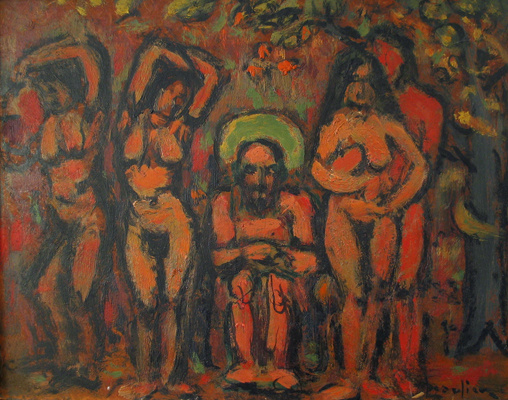Paul Vanier Beaulieu
Born in Montreal in 1910, Paul Beaulieu (Vanier, which he would later adopt, was his mother’s maiden name) was the eldest of seven children. P.V. Beaulieu was arguably one of the most divergent but pivotal painters of twentieth-century Quebec as his style grew to become quite reminiscent of the most important and influential modern painters of pre-WWI Paris.
He enrolled at the École des Beaux-Arts de Montréal in 1927, but quit shortly after he became disappointed with the teachings he found there. He left for Paris in 1938, which exposed him to the political, intellectual and artistic stimuli of pre-war Paris. Paul Beaulieu met several leading artists there, including Pablo Picasso, whom he regularly visited in his atelier. He purchased a studio in the Mont Parnasse section of the city where he became a painter of landscapes, figures and still lifes in semi-abstract and modernistic styles. Influences of Picasso’s cubist style and many of his known figures and symbols can be noticed in Beaulieu’s works.
After war was declared in the fall of 1939 and Germany invaded Paris the following year, Paul Beaulieu and his brother Claude were arrested and imprisoned until the Libération in 1944. In 1945, the artist returned to Montreal for a short period before returning to Paris in 1947. His return to Europe corresponded to the first important chapter in his oeuvre. His favourite theme was still life, which he explored with great originality, juxtaposing the integrated landscape in the background to the ensemble of the piece. He exhibited with William Armstrong in Montreal at the Waldorf Galleries, 1953, and held his first one man show at the Dominion Gallery in 1957 and held another showing of 58 paintings there in the autumn of 1959. He exhibited in Quebec, Toronto, New York, Mexico City, Rio de Janeiro, and other centres. He is represented in the Quebec Provincial Museum; The Montreal Museum of Fine Arts; the Bezalel Museum in Jerusalem, and the Museum of Modern Art, Paris.
Beaulieu’s oeuvre is not limited to still life and landscape. He explored many other themes, including portraits, whimsical scenes populated by acrobats and puppets, as well as avant-garde non-figurative compositions. Ultimately, it was the deviant modernist rendering of his shapes and forms that gave rise to and influenced more experimental painting in his native Quebec.
c/o: "A Dictionary of Canadian Artists, Volume I: A-F", Colin S. MacDonald, Canadian Paperbacks Publishing Ltd, Ottawa, 1977 / Photo: Rene Picard, 1962
Selected Major Exhibitions:
1935 : Premier Grand Salon des anciens de l'École des beaux-arts de Montréal
1953 et 1954 : Galerie Waldorf, Montréal
1958 : Exposition Trois peintres canadiens, Musée d’art moderne de Paris
1958 : Musée des beaux-arts de Montréal, Galerie XII avec Jean Dallaire
1965 : Galerie Camille Hébert
1977 : Galerie Bernard Desroches
1994 : Galerie Simon Blais
1996 : Musée des beaux-arts du Mont Saint-Hilaire
2009 : A Retrospective, Galerie Walter Klinkhoff
2013 : Paul Vanier Beaulieu: Survol de son univers, Musée d’art contemporain de Baie Saint-Paul
Selected Permanent Collections:
Collection d'œuvres d'art, Université de Montréal
Musée d'art contemporain de Montréal
Musée d’art moderne de Paris
Musée des beaux-arts de Montréal
Musée des beaux-arts de Sherbrooke
National Gallery of Canada, Ottawa ON
Museum of London, London ON
Musée national des beaux-arts du Québec
Bezalel Museum, Jerusalem



